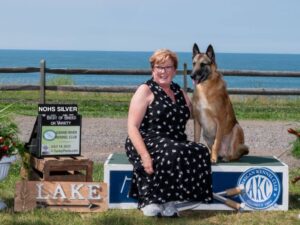
Barbara Arney | Belgian Laekenois
Discover insights from Barbara Arney, Belgian Laekenois breeder, on the breed’s status, challenges, and the future of the dog show community.

Home » Dog Breeds » Belgian Laekenois Dog Breed
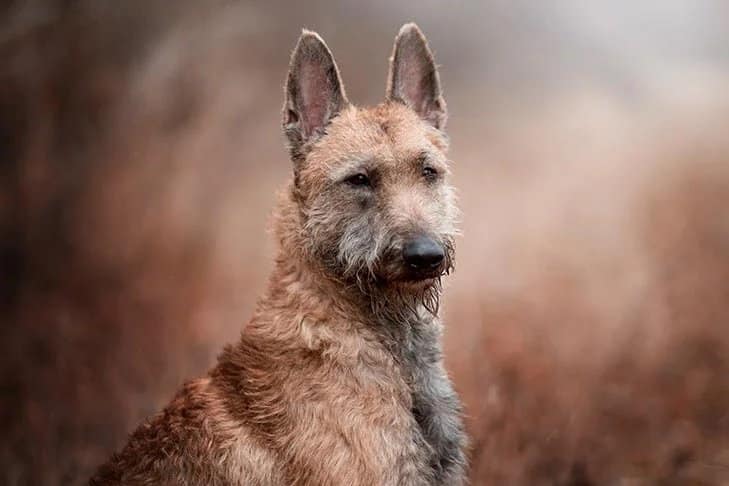
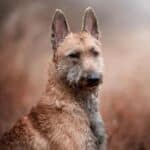
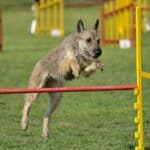
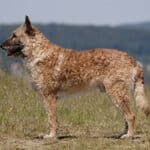
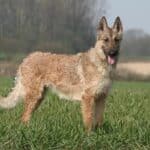
The Belgian Laekenois is one of the four Belgian shepherd breeds, each distinguished primarily by coat type. Named after the Belgian town of Laeken, this breed is the rarest of the Belgian breeds. Originally developed as a shepherd and guard dog, the Laekenois is recognized by its rough and tousled coat, alert demeanor, and unwavering loyalty.
The Laekenois is considered a separate breed by some registries, and a single variety of the Belgian Shepherd Dog by others.
Herding
22 – 26 Inches
55 – 65 Pounds
10 – 12 Years
| Country of Origin | Belgium |
|---|---|
| Bred For | Herding, Guarding, Companionship |
| Known For | Intelligence, Agility, Alertness, Devotion |
| Popularity | Low |
| Temperament | Intelligent, Courageous, Alert, Protective, Affectionate |
| Activities | Herding, Running, Hiking, Conformation Shows, Dog Sports |
The Belgian Laekenois is one of four distinct herding breeds (or varieties) that hail from Belgium, the others being the Belgian Malinois, Belgian Tervuren, and Belgian Sheepdog. Each breed/variety was named for the region or area in which it was predominantly developed. The Laekenois, in particular, finds its origin from the town of Laeken.
Historically, the primary role of the Belgian Laekenois was that of a herding dog, specifically used for guarding. The breed’s vigilant nature made it the perfect watchdog, alerting farmers to potential threats to their livestock. Beyond herding, the Laekenois was also used by local farmers and landowners as guardians for their estates and properties.
The distinction between the four Belgian shepherd breeds/varieties came about during the late 19th century, when dog enthusiasts in Belgium began to standardize their national breeds. Each of the four Belgians was recognized for its distinctive coat type, color, and/or region of origin. The Laekenois is characterized by its rough, curly coat that provides protection against the elements and potential predators.
World War I and World War II brought about a decline in the breed’s numbers, as many were used for military purposes. The Laekenois’ role varied from that of a messenger dog to guard dog, showcasing the versatility of these canines on the battlefield.
Official recognition has varied for the breed. While they’ve long been recognized by the Fédération Cynologique Internationale (FCI) and The Royal Kennel Club (UK), it took longer for the American Kennel Club (AKC) to grant full recognition. In 2008, the Belgian Laekenois was sanctioned to participate in AKC Herding Events for “suffix titles” and gained eligibility to compete in Companion Events. By 2011, the breed was permitted to compete in the Miscellaneous Class. The breed achieved full recognition by the AKC in 2020 and was subsequently moved to the Herding Group, marking its official standing among the fully recognized Herding breeds at AKC-sanctioned events.
Despite its extensive history and capabilities, the Belgian Laekenois remains one of the lesser-known Belgian breeds, often overshadowed by the more popular Malinois. Nevertheless, enthusiasts of the breed cherish the Laekenois for its unique appearance, intelligence, and loyal nature.
Preserving the history and characteristics of the Belgian Laekenois has been a collaborative effort between breed clubs, breeders, and breed enthusiasts. The dedication of these individuals ensures that future generations can appreciate this distinct and delightful breed.
Adult male Belgian Laekenois typically stand between 24 and 26 inches tall at the shoulder, while mature females are slightly smaller, usually measuring from 22 to 24 inches tall.
When it comes to weight, males generally range from 55 to 65 pounds, whereas females tend to weigh between 45 and 55 pounds. These measurements reflect a well-balanced and athletic physique, ideal for the breed’s herding and guarding duties.
The Belgian Laekenois possesses a harmonious proportion in its build, maintaining a balance between length and height. Females may be slightly longer than their male counterparts. This breed is solid and well-muscled, but without any hint of heaviness or clumsiness. Its bone structure is moderate, and its overall substance reflects a combination of strength, agility, and endurance.
Texture: The Belgian Laekenois boasts a rough and tousled coat. The wiry texture not only gives the breed its distinctive appearance, it also offers protection from the elements. Unlike the other Belgian breeds/varieties, the Laekenois has a beard and a coarse coat, which can feel dry to the touch.
| Standard Color | |
|---|---|
| Black & Tan | ee |
| Fawn | ee |
| Mahogany | ee |
| Red Sable | ee |
| Cream Sable | ee |
| Fawn Sable | ee |
| Red | ee |
| Cream | ee |
A Note About Color: All shades of red or fawn to grayish tones are acceptable. The degree of black tracing varies considerably, but is primarily seen on the muzzle and on the tail. A small to moderate amount of white on the chest and/or the tips of the toes is acceptable. Solid white markings elsewhere are unacceptable.
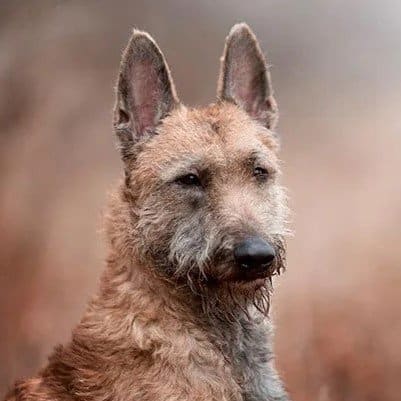
The tail of the Belgian Laekenois is a defining aspect of its overall silhouette. It extends naturally from the line of the spine, providing balance to the dog’s athletic build.
The Laekenois’ tail is strong at the base and gradually tapers to a point. When the dog is relaxed, the tail hangs down and reaches at least to the hock. In moments of excitement or activity, it may raise slightly but never curls over the back.
Traditionally, the tail of the Belgian Laekenois is always left undocked, displaying its natural length and characteristic movement. This undocked appearance adds to the breed’s rustic and unrefined look, which is typical of a working dog.
Owning a Belgian Laekenois is a rewarding experience, but it also comes with responsibilities. This breed’s intelligence, energy, and loyalty make it a unique companion, but potential owners should be prepared to meet its physical and mental needs. Understanding the various aspects of its care, health, and temperament is crucial for ensuring a harmonious relationship.
The Belgian Laekenois is generally a robust and healthy breed, benefiting from its working dog lineage. However, like all breeds and mixed breeds, the Laekenois can be predisposed to certain health conditions. Regular veterinary check-ups, a balanced diet, and adequate exercise can help with maintaining optimal health.
Lifespan: The average lifespan of a Belgian Laekenois ranges from 10 to 12 years. This can vary based on factors like genetics, health care, and overall lifestyle.
As with all dogs, the Belgian Laekenois may be susceptible to specific health risks, although responsible breeding and proper care can reduce the likelihood of these conditions. Some of the more common health issues associated with the Laekenois include:
Regular veterinary check-ups of the Belgian Laekenois can help in early detection and management of these and other potential health risks. It’s also beneficial for potential and current owners to be aware of these concerns and to consult with breeders about the overall health of their dogs.
Diving into the multifaceted world of the Belgian Laekenois, one encounters a breed defined by its intelligence, loyalty, and alertness. Originating from a strong working background, the Laekenois exhibits a blend of traits that make it both captivating and challenging.
For novice dog owners, the Belgian Laekenois might be a bit of a handful. The breed’s eagerness to please and unwavering devotion are commendable. However, their sharp intellect and spirited energy demand an owner who’s up for the task. Without consistent training and regular outlets for its physical and mental energy, the Laekenois might become a challenge to manage.
Sensitivity courses through the veins of the Belgian Laekenois. These dogs form profound bonds with their families, resonating deeply with their owner’s emotions and nuances. This sensitivity underscores the importance of gentle training methods and positive reinforcement.
Loneliness isn’t part of the Belgian Laekenois’ wheelhouse. This dog’s attachment to its human counterparts runs deep, making prolonged periods of solitude a potential source of anxiety and undesirable behavior. On the brighter side, the breed’s bond with family, especially when formed from a young age, means it can be a wonderful companion for children. The Laekenois’ innate protective instincts often translate into being a loyal guardian for younger members of the household. Yet, caution is advised. The breed’s herding background might occasionally surface, leading an excited Laekenois to nip at the heels of running kids.
While Belgian Laekenois form deep bonds with their humans, with the right introductions and early socialization, these dogs can also coexist harmoniously with other dogs. That said, unfamiliar canine faces might be met with reservation or territoriality, stemming from the breed’s protective nature. Similarly, strangers might find the Laekenois a bit wary at first. The Laekenois’ watchdog instincts can make these dogs excellent at alerting to unfamiliar presences. But with the right introductions and training, their initial reservations can melt away, revealing a more accepting and friendly demeanor.
The nutrition of a Belgian Laekenois plays a pivotal role in its overall health and well-being. Being an energetic breed, the dietary needs of this dog can differ from those of more sedentary breeds, so understanding and providing the right nutrition is paramount.
For a Belgian Laekenois puppy, its growth demands a diet rich in essential nutrients and protein. Feeding specially formulated puppy food ensures every pup receives the necessary vitamins, minerals, and balanced protein-to-fat ratio that supports healthy growth and development. As puppies transition to adulthood, their dietary needs evolve. While protein remains a crucial component, adult Belgian Laekenois also benefit from fats, fibers, and other essential nutrients typically present in high-quality adult dog food.
When determining the amount of food to offer, several factors come into play, including the dog’s age, weight, metabolism, and activity level. Generally, an active adult Belgian Laekenois may require more food than its less active counterparts. It’s a good practice to start with the feeding guidelines provided on the dog food label and adjust accordingly based on each dog’s individual needs. Keeping an eye on the Laekenois’ weight and body condition can help to determine if it needs a bit more or less food. Regular consultations with a veterinarian can provide guidance tailored to individual needs.
The number of meals given per day also depends on the age and preference of the Belgian Laekenois. Puppies typically need multiple small meals throughout the day to support their growth. As they mature, this can be reduced to two meals a day, although some owners prefer to stick with more frequent, smaller meals to aid in digestion and energy management.
Regardless of age, always ensure that the Belgian Laekenois has access to fresh, clean water.
Training a Belgian Laekenois can be both a rewarding experience and a challenge. As members of the Herding Group, these dogs come equipped with intelligence, energy, and a keen sense of purpose. Harnessing these attributes in the right direction is key to a successful training journey.
Belgian Laekenois are generally eager to learn, making them relatively easier to train compared to some breeds. Their high intelligence ensures they quickly grasp commands and lessons, but this also means they can get bored if the training is too repetitive or lacks mental stimulation. A varied regimen that challenges their cognitive skills can keep them to remain engaged and enthusiastic.
One potential hiccup in training a Laekenois might be the breed’s vocal nature. These dogs have a tendency to bark, whether it’s out of excitement, as an alert, or merely to communicate. This can become problematic if not addressed. However, with consistent training and socialization, the frequency and intensity of barking can be controlled.
Another aspect to be mindful of with the Laekenois is the breed’s wanderlust potential. While Laekenois are deeply loyal and typically stick close to their humans, their curiosity might sometimes get the better of them, leading these dogs to explore beyond their owner’s property boundaries. Hence, recall training from a young age is crucial for this breed.
Given their herding ancestry, some Belgian Laekenois may display a higher prey drive, especially around smaller animals. Early socialization and introducing these dogs to various sights, sounds, and creatures can help to curb this instinct and ensure they behave appropriately around other animals.
The Belgian Laekenois, a hardworking herding breed, is not content to just lounge around. This breed is characterized by a robust energy level and a passion for staying active. Meeting the exercise needs of these dogs is not just beneficial—it’s essential for their overall well-being and happiness.
| Energy Level | Moderate to High |
|---|---|
| Exercise Requirements | 1 Hour/Day (Minimum), Daily Walks, Vigorous Running, Regular Exercise, Playing with Another Dog, Mental Stimulation |
The energy level of Belgian Laekenois ranges from moderate to high. This means daily physical activity is a must. Regular walks, runs, and interactive play sessions can keep them satisfied. Without adequate outlets for their vigor, they might resort to undesirable behaviors, such as excessive barking or destructive tendencies.
The intensity with which a Belgian Laekenois approaches physical activity is commendable. These dogs will often give their all, whether it’s during a game of fetch or while chasing after a toy. Their herding instincts can sometimes come into play, so they’re likely to enjoy activities that mimic the challenges and patterns of herding.
As for their playfulness, Belgian Laekenois often retain their puppy-like enthusiasm well into adulthood. This makes play sessions not just an opportunity for physical exercise but also a time for bonding with their humans. They often thrive in activities that challenge both their body and mind, such as Agility or Obedience Trials.
However, while they may seem tireless, it’s crucial to ensure they don’t overexert themselves, especially in extreme weather conditions. Regular breaks, access to fresh water, and shade during hot days are all essential.
The Belgian Laekenois, with its unique, rough-textured coat, requires specific attention when it comes to grooming. While these dogs might not need the regularity of grooming sessions as some other breeds, proper care ensures that their coat remains healthy and looking its best.
| Coat Type | Rough, Coarse, Medium Length, Tousled |
|---|---|
| Grooming Requirements | Weekly Brushing, Occasional Bathing, Routine Ear Cleaning, Periodic Nail Trimming, Regular Tooth Brushing |
Their coat, being rough and tousled, can trap dirt, debris, and loose hair. Regular brushing, ideally once or twice a week, can help to remove these particles and prevent the coat from matting. This routine not only ensures the coat remains clean, it also aids in distributing the natural oils, promoting a healthier skin and coat.
When it comes to shedding, the Belgian Laekenois is not a heavy shedder. However, this breed does have seasonal shedding periods, particularly during the spring and fall, when brushing might need to be done more frequently.
Bathing the Belgian Laekenois doesn’t need to be a frequent affair. Given their coat’s texture, frequent baths can strip the natural oils from the coat, leading to dryness. Instead, bathing should be done on an as-needed basis, such as when the dog gets particularly dirty or starts to emit an odor.
Other aspects of grooming, like nail trimming, ear cleaning, and dental care, are just as crucial. Regular nail trims prevent overgrowth and potential foot complications. Cleaning ears occasionally will ensure a dog is free from debris or signs of infection. As for tooth care, regular brushing or vet-approved dental chews can help in preventing tartar build-up and maintaining oral health.
Having a Belgian Laekenois as a companion means sharing space with an intelligent, energetic, and protective breed. Adapting one’s living situation to accommodate the needs of the dog can make cohabitation smoother and more fulfilling for both the Laekenois and its human family.
When it comes to apartment living, Belgian Laekenois can adapt as long as their exercise and mental stimulation needs are met. While they appreciate open spaces to run and play, they can manage in smaller living spaces if they receive adequate physical activity and interaction. Regular walks, playtime, and possibly trips to a nearby park can make apartment living more feasible.
The Belgian Laekenois is also sensitive to extreme temperatures. In cold weather, the breed’s dense coat offers some protection, but it’s essential to be mindful of particularly chilly conditions. Laekenois might sometimes require additional warmth provided by a doggy sweater, especially if they are out for extended periods. On the flip side, in hot weather, they can be prone to overheating. It’s crucial to provide them with a cool environment, shade, and plenty of water during warmer months. Activities should be scheduled during cooler parts of the day to ensure the Laekenois’ safety.
If an enclosed yard is available, the Belgian Laekenois will appreciate the freedom to explore and play. However, it’s vital to ensure the yard is securely fenced. Given the breed’s natural curiosity and potential for wanderlust, a sturdy fence can prevent the dog from venturing out unsupervised.
The joy of bringing a Belgian Laekenois puppy into the home is immeasurable. These little bundles of energy, with their distinct rough coat and curious eyes, are a sight to behold. However, as with any puppy, these energetic tykes require care, patience, and a conducive environment to grow into well-adjusted adults.
Caring for a Belgian Laekenois puppy begins with understanding its specific needs, both physically and emotionally. Nutrition is paramount during this growing phase. Feeding a high-quality puppy food that meets the pup’s dietary requirements ensures it will develop strong bones, a robust immune system, and good overall health.
As puppies, their energy levels can be high. Incorporating playtime, short walks, and interactive toys can help to channel their energy constructively. It’s essential to remember that while they are energetic, their bones and joints are still developing. Avoiding strenuous activities or jumps can help to prevent potential injuries.
Early socialization is crucial for the Belgian Laekenois. Exposing puppies of this breed to various environments, sounds, people, and other animals can help to shape their temperament. Positive experiences during their formative months can lead to their becoming well-rounded adult dogs that are confident and less reactive to unfamiliar situations.
Training should also commence early for Belgian Laekenois pups. Basic obedience classes or even simple commands taught at home can set the foundation for future training endeavors. Given the breed’s intelligence, these dogs are quick learners, but consistent, positive reinforcement methods work best.
Regular vet check-ups, vaccinations, and preventive treatments for parasites are vital components of every puppy’s early care. Routine visits can ensure they are growing healthily and allow time to address any potential health concerns promptly.
Lastly, love, patience, and understanding play a significant role in every Belgian Laekenois’ development. Establishing a bond with the dog as a puppy, ensuring it feels safe, loved, and part of the family, can make integration into the household a seamless and fulfilling experience.
The Belgian Laekenois, with its heritage as a versatile working dog, has a natural inclination towards activity and sports. The breed’s intelligence, agility, and drive make these dogs well-suited for a variety of activities that not only satisfy their physical requirements but also stimulate them mentally.
Participating in these activities and sports can strengthen the bond shared between the Belgian Laekenois and its handler. Additionally, it provides the dog with a constructive outlet for releasing its energy and expressing its intelligence. Whether for competition or just for fun, these activities can be immensely rewarding for both the dog and its human partner.
The Belgian Laekenois is recognized by the world’s leading registries and kennel organizations, which categorize the breed into a specific Group based on its unique characteristics. This breed is recognized worldwide under the following Group designations:
| Organization | Group Designation |
|---|---|
| AKC (American Kennel Club) | Herding |
| UKC (United Kennel Club) | Herding Dog |
| CKC (Canadian Kennel Club) | Herding |
| ANKC (Australian National Kennel Council) | Working |
| RKC (The Royal Kennel Club) | Pastoral |
| FCI (Fédération Cynologique Internationale) | Group 1: Sheepdogs and Cattledogs Section 1: Sheepdogs |
The ideal Belgian Laekenois is described by a Breed Standard that is approved by each of the world’s leading registries and kennel organizations. The Breed Standards for this breed may be found in the following links:
| Organization | Breed Standard |
|---|---|
| American Kennel Club | AKC Belgian Laekenois Breed Standard |
| United Kennel Club | UKC Belgian Laekenois Breed Standard |
| Canadian Kennel Club | CKC Belgian Laekenois Breed Standard |
| Australian National Kennel Council | ANKC Belgian Laekenois Breed Standard |
| The Royal Kennel Club | RKC Belgian Laekenois Breed Standard |
| Fédération Cynologique Internationale | FCI Belgian Laekenois Breed Standard |
Breed clubs play a crucial role in preserving the Standards, health, and history of a dog breed. For the Belgian Laekenois, these organizations not only act as guardians of the breed Breed Standard but also foster a community of enthusiasts, breeders, and owners who share a common passion for the Laekenois.
The American Belgian Laekenois Association (ABLA) is the primary breed club for the Belgian Laekenois in the United States. Affiliated with the American Kennel Club (AKC), the ABLA promotes the health, temperament, and working ability of the breed through various events, educational programs, and breed-specific programs and resources.
In Canada, the Belgian Shepherd Dog Club of Canada (BSDCC) oversees matters related to all four Belgians, including the Laekenois. This club works diligently to promote responsible breeding and ownership while also organizing events to showcase the capabilities and beauty of the breed.
The Belgian Shepherd Dog Association of Great Britain serves as the primary club for Belgian Shepherds in the UK. Dedicated to all four varieties, this club provides breed information, organizes events, and offers guidance on responsible breeding and ownership.
Adopting a rescue dog can be a rewarding experience, and the Belgian Laekenois is no exception. While the breed is relatively rare, there are instances where individual dogs might need a new home due to various circumstances. Thankfully, several rescue organizations and groups work faithfully to ensure that these dogs find loving and suitable forever homes.
In the United States, the American Belgian Laekenois Association (ABLA) facilitates rescue operations for the breed. While not exclusively a rescue organization, the ABLA has resources and connections to assist Laekenois in need and guide potential adopters through the process.
In Canada, the Belgian Shepherd Dog Club of Canada (BSDCC) can serve as a starting point for those interested in rescuing or adopting a Belgian Shepherd, including the Laekenois. They can provide guidance and potentially connect prospective adopters with available dogs or other rescue organizations.
The Belgian Shepherd Dog Association of Great Britain is the primary point of contact for all matters related to Belgian Shepherds in the UK. While primarily a breed club, this organization also has knowledge of rescue situations and can help to guide those looking to adopt a Laekenois.
Yes, the Belgian Laekenois does shed. The breed’s unique coat will lose hair periodically, but this is not considered a heavy shedder. Regular grooming can help to manage the coat and reduce the amount of hair around the house.
While the Belgian Laekenois isn’t a breed known for excessive barking, its watchdog instincts can make it vocal when sensing unfamiliar people or animals. Early training can help to moderate unnecessary barking.
The Belgian Laekenois is known for its loyal and protective nature. As a family dog, it can be loving and affectionate with its household members. Proper socialization and training are essential, however, to ensure a positive relationship, especially around young children and other pets.
Definitely. The breeds’ intelligence, trainability, and alert nature make it suitable for service roles. They can be trained for specific tasks and can be seen in roles such as Therapy or Assistance Dogs.
The Belgian Laekenois is a devoted breed and enjoys being around its family. While it can handle solitude for short durations, prolonged isolation isn’t ideal. Consistent solitude might result in feelings of loneliness and, potentially, some unwanted behaviors. If a Laekenois has to be left alone, providing interactive toys or considering doggy daycare can prove beneficial.
Belgian Laekenois are moderate maintenance dogs. Given the breed’s active nature, they do require regular physical activity to be content. Their rough, wiry coat does require grooming; however, not as frequently as some other coated breeds.
Absolutely. Originally a herding dog, the Belgian Laekenois has transitioned into various roles in the modern world, including police and military work. The alertness, intelligence, and dedication of these dogs make them excellent partners in different working environments.

Discover insights from Barbara Arney, Belgian Laekenois breeder, on the breed’s status, challenges, and the future of the dog show community.
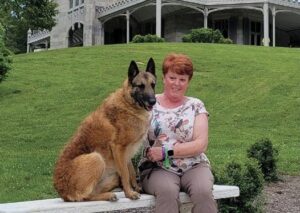
Barbara Arney | Belgian Laekenois, my sister had a best friend who showed Belgian Sheepdogs. I went to a few shows to watch her and
The best way to ensure a long and happy relationship with a purebred dog is to purchase one from a responsible breeder. Not sure where to begin?
Contact the National Parent Club’s Breeder Referral Program, which is listed on the AKC Breeder Referral Contacts page.
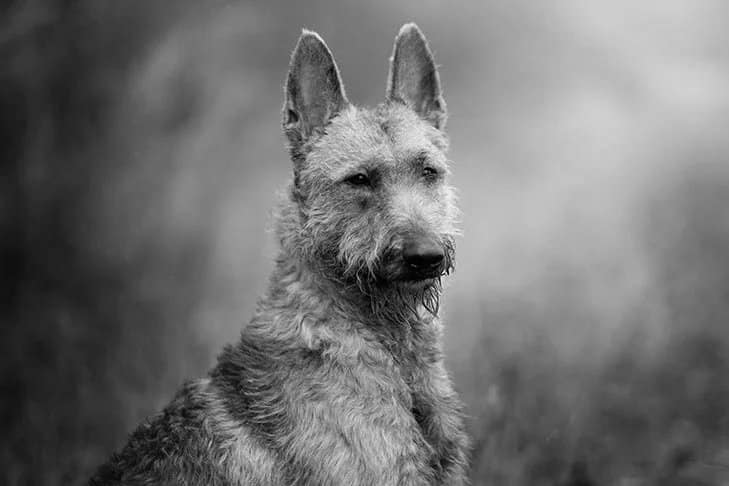

"*" indicates required fields
Showsight Magazine–the world’s most influential purebred dog publication since 1992. Each issue reaches a global audience dedicated to preserving the history and health of purpose bred dogs. Filled with award-winning editorial focused on news and insights from the dog show community, top breeders, handlers, AKC Judges, and more!